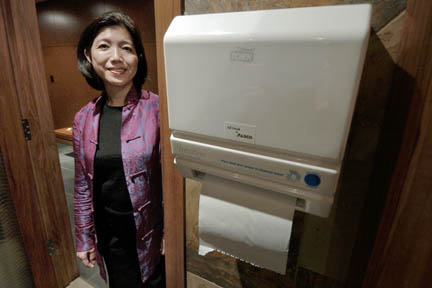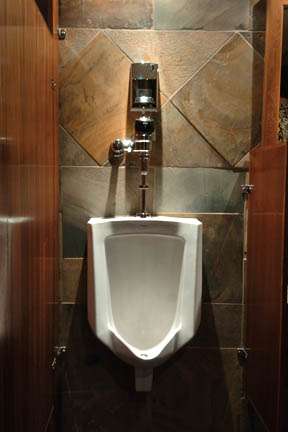
Shanghai Bistro owner Li May Tang has installed high-tech, no-touch bathroom fixtures such as a paper towel dispenser that rolls out a single sheet when it senses a hand beneath it.
Building a better bathroom
Hands-free approach creates
the cleanest environment when
nature is calling
Hold it!
That's the impulse for most when they're in the middle of holiday shopping and the inevitable occurs: Nature calls. It's no wonder you refrain -- recalling your last public restroom experience, you dread a repeat visit to that venue.
Eventually, bow to the urge you must, and with each step toward the little man or woman icon on the door, you brace yourself for the challenges that lie ahead.
Did the person before forget to flush? Or worse, is the toilet clogged? Is it stocked with toilet paper? Seat covers? Paper towels? Will you need to resort to tricky maneuvering involving the lifting of pant legs or muumuu? Or hold your breath until your mission is complete?
There's no need to worry about any of that at Shanghai Bistro. Restaurant owner Li May Tang is the first in Hawaii to take advantage of the latest in bathroom gadgets.
The eatery opened its doors at the Discovery Bay Center this summer, and its restrooms have received as much fanfare -- if not more -- as its food, with write-ups in several island publications.
They're equipped with automated or infrared "touchless" features, including paper towel dispenser, water faucets, flush mechanism and air fresheners.
But the star of this particular spot is a toilet seat cover that encircles the commode, fitted in the same way a shower cap would be to one's head -- if one's head were doughnut-shaped. With a push of a button, a clean "cap" is released and runs across the "doughnut" rim like a snake or a train on a track, replacing the old one, which is swallowed up, disappearing into a "used" side.
"Customers are so excited, they play with (the toilet seat cover)," said Tang. "We had to put up a sign" hoping to limit them to just one push per use."

Urinals are equipped with sensors that automatically flush at the appropriate times. In addition, a scented bleach solution is pumped into the water every 15 minutes.
"When I go to a restaurant, if the bathrooms are messy, I don't eat there again because what does that say about how clean their kitchen is?"
Cleanliness is a high priority, so even if the restrooms are high tech, they are checked regularly. But less employee time is spent on cleanup thanks to the new devices.
There definitely is a savings when businesses automate, said Michael Green, sales manager of Alsco, which provides the equipment and maintenance service to Shanghai Bistro. Besides allowing employees more efficient use of their time, there's not so much waste.
"The multifold towels, especially, people just grab them by the handfuls," Green said.
"Touchless" bathrooms are doing well across the country in stadiums and airports, and the restaurant industry is slowly realizing its merits, he said.
Though some restaurants have installed a few of the devices, Shanghai Bistro is thus far the only one in Hawaii to pick up the whole system. Paper towels are dispensed when a user passes a hand in front of a moisture-detecting sensor; the seat cover is activated by motion sensor, with a backup push-button; air freshener is constant, its scent misted into the room with a fan; and an "automatic janitor" releases cleaning solvent into the toilet every 15 minutes.
"It's a 24/7 cleaner and disinfectant," said Green.
Toilet paper is dispensed the old-fashioned way, but there's a backup roll ready and waiting for duty. Tang plans to replace the current soap dispenser with a hands-free one soon.
Tang rents the equipment from Alsco, which provides maintenance once a week. She also has a linen contract with the company that provides visits three times a week, allowing for bathroom spot-checks.
During this busy season -- with thousands taking shopping breaks or attending Christmas parties at restaurants -- patrons will notice when it comes time to make that important stop.

With the push of a button, a fresh plastic cover automatically encircles the toilet seat.
Tang agreed. "Another thing people do is hold their children over the seat; they don't even put them down," or they instruct their children to squat over the bowl with their feet on the rim.
Green has trained his 6-year-old grandson Keahi in the art of public restroom use so well, he recalls having to tell him, "No, no, no, we don't need to kick the toilet handle to flush at Grandma's. When you go out, you don't touch that, but when you go out and visit Grandma, it's OK."
Whether these products will ever cross over to the residential side, as did stainless-steel commercial kitchens, Green said, "It's not really our market, we service businesses; but when employees first saw this, they this asked, 'Can I get this for my home?'
"At home it's different," said Green. "You don't clean the toilet with every use, but you know who's using it. Public areas, you don't know, and it's incumbent on the owners to provide clean facilities."
Perhaps some products, such as automatic air fresheners or soap dispensers, would make the transition, Green said, as well as automatic faucets for people whose children forget to turn them off. They'd be pricey for the typical homeowner, but he could see it all fitting nicely into a high-tech home.
As far as the head act at Shanghai Bistro, it's novel enough to make bathroom conversation during mealtime OK, and first-time patrons will return to their tables, telling the rest, "You have to go."
Watching the toilet seat cover spin into place for the first time beats your typical pull-the-tissue-paper-from-the-dispenser-place-it-and-sit experience, hands down. You'll be tempted to press that button again, wishing you could see it in slow-mo, despite the sign that politely asks you to do otherwise.
Green speculates that patrons with itchy fingers are simply curious whether the toilet seat cover is being recycled.
But, of course, "It's a fresh layer."
[News] [Business] [Features] [Sports] [Editorial] [Do It Electric!]
[Classified Ads] [Search] [Subscribe] [Info] [Letter to Editor]
[Feedback]
